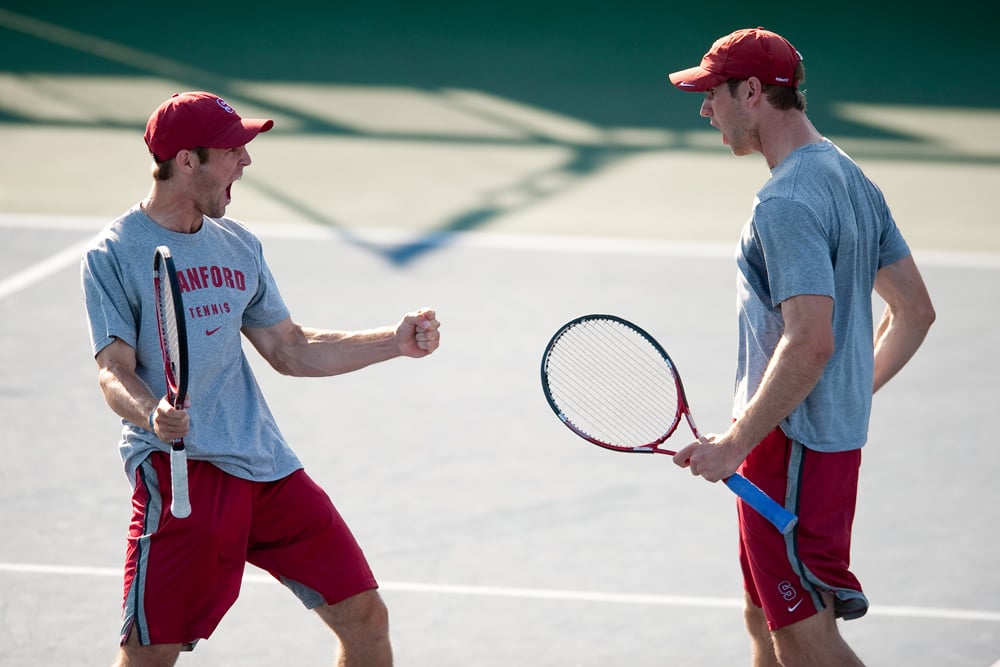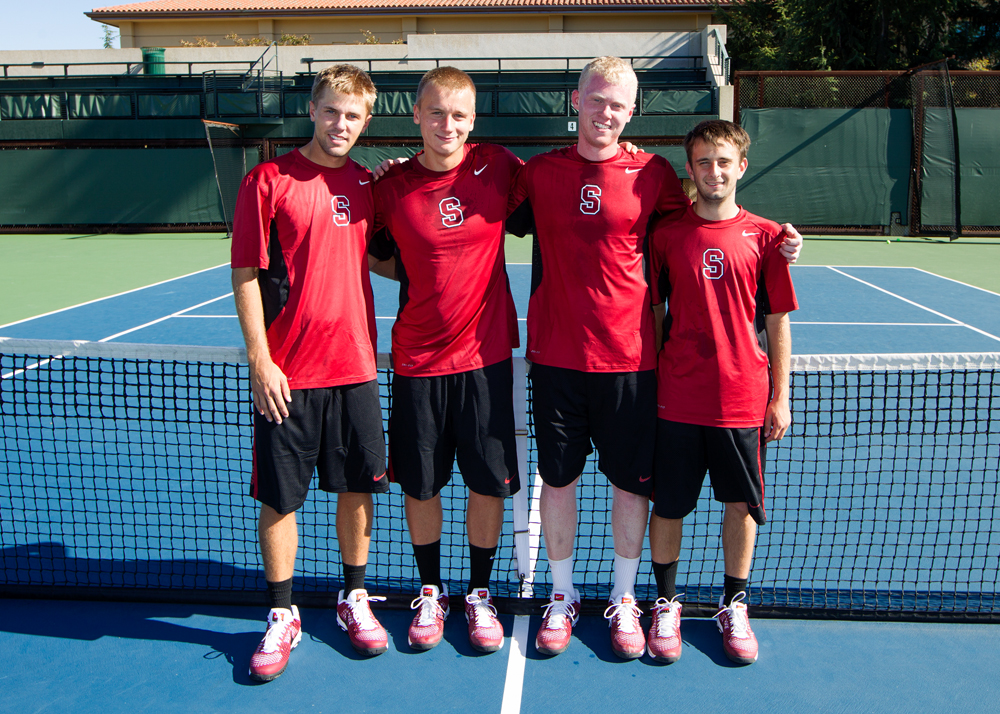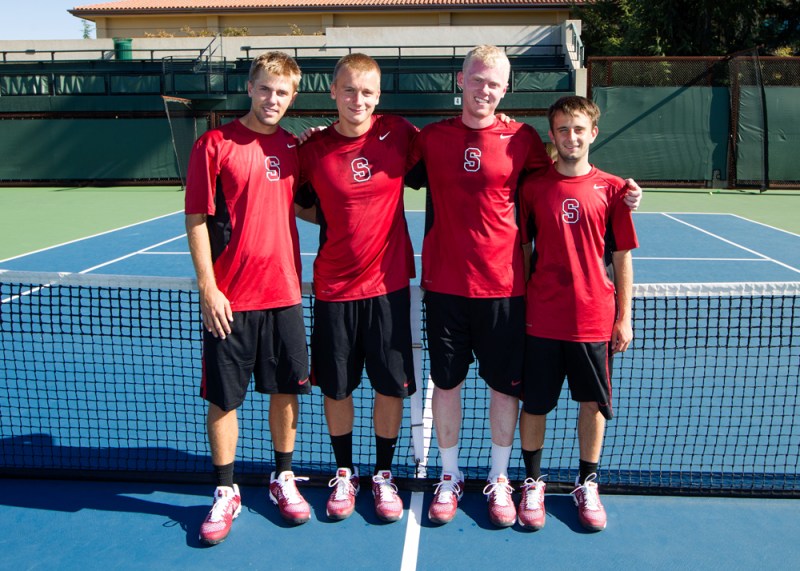There’s an old saying that says “Go West, young man.”
On Friday, I decided to ignore these words of wisdom and head east on campus, towards Taube Family Tennis Stadium, where the Stanford men’s tennis team was set to take on the Washington Huskies in a late-season Pac-12 match.
For someone like me who peaked in the USTA 14-and-under division after making the crucial realization that the goal was to keep the ball in the court as opposed to hitting it over the fence, I have always had an appreciation for the grace with which collegiate tennis players play the game. And for someone who was looking to watch great college tennis, what better school to attend than Stanford?
For those of you who haven’t gotten the chance, I encourage you to take a trip to the tennis stadium. Outside, you’ll find more plaques than palm trees on Palm Drive, enumerating the 34 combined (17 each) NCAA Division I national championships that the men’s and women’s teams have won.

If you further peruse the NCAA history books, you’ll find that 14 Stanford men’s players have also won the NCAA singles championships and 14 Stanford pairs have won the NCAA doubles championships. Keep reading the history books, and you’ll see that seven Stanford players — including current head coach John Whitlinger — have won both the singles and doubles championships.
The bottom line is that the often-overused word “dynasty” (sorry, Miami Heat fans) is probably an understatement for the Stanford men’s tennis program. Players such as John McEnroe, Sandy and Gene Mayer, Roscoe Tanner and Tim Mayotte (all former top-15 singles players in the world) have donned the cardinal and white, and that incredible list does not even include doubles phenoms like the Bryan Brothers, Jim Grabb, Alex O’Brien, Jonathan Stark and Jared Palmer — all of whom have been ranked number one in the world in doubles.
The only downside to having this type of program history is that when the going gets tough, it causes people to sometimes irrationally rush to exaggerated reactions. It’s not uncommon to hear fans asking questions like, “How did this happen?” or, “Are we ever going to have an ‘elite’ program again?”
It seems that questions such as these are now surrounding the men’s tennis program at Stanford. Last year, the team finished an uncharacteristic 12-12, which included losing in the first round of the NCAA tournament to No. 20 LSU. Despite their impressive 12-4 record this season, the team is only ranked 43rd (although this ranking is sure to go up in the ITA rankings following Stanford’s consecutive wins over Washington and No. 39 Oregon). Thus, the question that I pondered while sitting at Taube Family Tennis Stadium on Friday was “What is the future of the men’s tennis team?”
First, keep in mind that it was just two seasons ago that Stanford reached the NCAA Quarterfinals under the senior leadership of the dynamic duo of Bradley Klahn and Ryan Thacher.
To get some perspective on just how big the loss of these two stars was to the program, consider the fact that Klahn was the NCAA singles champion as a sophomore and is now the second highest-ranked American in the world. Thacher posted a 94-46 singles record during his time on the Farm, and he combined with Klahn to capture back-to-back Pacific Coast Doubles championships (something that had not been done since the 1990-1991 season).
“It’s tough. Klahn is an NCAA champion; Ryan was a three-time Kalamazoo [the nation’s top junior tennis tournament] finalist,” Whitlinger said. “It’s never easy.”
Last season, it was clear that the team felt the effects of youth and the loss of its top two players. John Morrisey found himself vaulted from the number four to the number one singles court in just a year, and freshmen such as Nolan Paige, Maciek Romanowicz and Trey Strobel found themselves playing in meaningful singles matches in only their first years.
Who wouldn’t expect there to be an adjustment period? Was it really reasonable to expect the team to fill the shoes of two of the best collegiate tennis players of the decade without even the slightest hiccup?

The fact that the team made the NCAA tournament last year was a testament to the coaching staff and player development that happens at Stanford. Considering that the norm in tennis is for the top junior players to either leave college early to turn pro or skip college altogether, it really says something about this staff that a player like Klahn, who achieved the ultimate accolade as a sophomore, would return for two more years of collegiate tennis. Why should we be skeptical at all, then, of whether this same coaching staff will have Stanford competing for national championships again in the very near future?
This season, Stanford started off 4-2, with losses to No. 3 Georgia and No. 9 California. Moreover, what’s not included in this 4-2 record is that Stanford’s Feb. 9 match against No. 2 UCLA was officially scored as “rained out,” despite the fact that the Cardinal had won the doubles point and four first sets out of the six singles courts.
How easy would it have been for this team to throw in the towel back in February?
Every excuse was on their side. Nolan Paige, one of the key freshman contributors from the previous season, was ill all winter quarter, and the match that was supposed to be Stanford’s “big win” was rained out at the most inopportune moment for the Cardinal. What’s more is that the Cardinal were staring down a spring break schedule that featured matches in Las Vegas, Salt Lake City and Tucson in the span of five days.
Nonetheless, in three closely contested matches, the Stanford Cardinal prevailed against all three opponents 4-3, and at the start of April, the Cardinal found itself back in the rankings at No. 52 following what Whitlinger called “one of the toughest road trips that we’ve ever had.”
However, just two days after arriving back on the Farm from Tucson, the team faced its biggest challenge since in over a month against No. 22 Boise State.
Surely this was the moment where the team would finally falter, right? How could we expect an exceptionally young team on two days rest after having won three straight matches 4-3 on the road to beat a top-25 team?
As you might know, Stanford dismissed Boise State 4-0, featuring a singles lineup with three sophomores, two juniors, and one senior.
Just like that, the winning streak reached six matches in a row. After a tough trip down to Southern California which saw Stanford lose to No. 3 USC (who won four consecutive national championships from 2008-12) and No. 2 UCLA (last year’s NCAA runner-up), the Cardinal were back in action last Friday against Washington, which brings me full circle to the start of this article.
I can honestly say that Friday’s home match against Washington was the most exciting collegiate match that I’ve ever seen. Stanford found itself in a familiar situation, with the match tied at 3-3. This time, the match fell into the racket of sophomore Anthony Tsodikov at number five singles. Tsodikov, who wasn’t even a part of the lineup his freshman year, played the role of hero in fighting off multiple match points to prevail 15-13 in a third-set tiebreaker.
“Being from San Francisco, it’s always been a dream of mine to play for Stanford,” Tsodikov said after the match. “When you’re a kid, you always look forward to when the match is 3-3 and you’re playing to win for the team — it’s like in the movies.”
I’ll never forget watching the entire team storm the court to celebrate with Tsodikov. Around me, fans were smiling, hugging and high-fiving. It was as if men’s tennis was back with a vengeance after a short hiatus, and the team we saw pull off this incredible victory was growing up before our eyes. A new identity was forming, and as Tsodikov would say after the match, “We had big shoes to fill, and hopefully we’re getting there.”
The very next day, Stanford followed up its thrilling victory against Washington by taking down No. 39 Oregon, continuing to build on its new identity.
“Klahn and Thacher were special,” Whitlinger said. “So were Bob and Mike Bryan, and so were a lot of the players that we’ve had. [But moving forward, new] guys step up. They improve, and they do better.”
This isn’t the first time that Stanford has lost great players, and it will certainly not be the last. Players, including those who will join the team next year as part of the nation’s top recruiting class, will continue to grow and thrive under the Stanford system.
This season, we’re seeing the beginning of a new chapter in a book filled with greatness.
I, for one, cannot wait to see how this chapter will end.
Shawn Tuteja’s hopes and dreams were lost when Stanford men’s basketball fell to Dayton in the NCAA Tournament and he immediately sought solace in the men’s tennis team. To tell Shawn why men’s tennis will make it past the Sweet 16, contact him at sstuteja ‘at’ stanford.edu.
